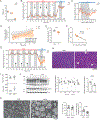Regulatory T cells in brown adipose tissue safeguard thermogenesis by restraining interferon-γ-producing lymphocytes
- PMID: 40712046
- PMCID: PMC12363373
- DOI: 10.1126/sciimmunol.ads0478
Regulatory T cells in brown adipose tissue safeguard thermogenesis by restraining interferon-γ-producing lymphocytes
Abstract
Whereas visceral adipose tissue (VAT) primarily stores excess energy, brown adipose tissue (BAT) dissipates it in a process termed nonshivering thermogenesis. Several key VAT features, particularly murine epidydimal VAT, are regulated by a distinct population of regulatory T (Treg) cells, raising the question of whether BAT hosts an analogous population. Although Treg cells have been observed in BAT, their properties and mechanisms of action require elucidation. We found BAT Treg cells to be heterogeneous in subtissular localization and subtype composition. Punctual depletion of Treg cells unleashed interferon-γ (IFN-γ)-producing lymphocytes in BAT, but not in subcutaneous or visceral fat depots, leading to IFN-γ-dependent mitochondrial dysfunction and metabolic dysregulation, thereby impeding nonshivering thermogenesis. Cold challenge selectively expanded the IL-18R1+ Treg subtype in BAT; stripping this receptor specifically from Treg cells unleashed IFN-γ-producing lymphocytes and compromised temperature control. Thus, control of local IFN-γ production is a core feature of Treg cell control of tissue homeostasis.
Conflict of interest statement
Figures







References
MeSH terms
Substances
Grants and funding
LinkOut - more resources
Full Text Sources

